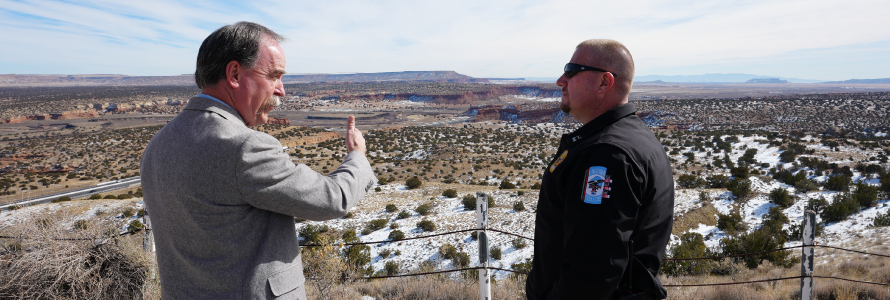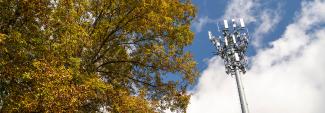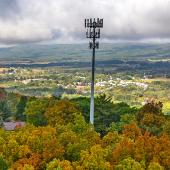The Navajo Nation spans across 27,000 square miles extending into some of the most rugged lands throughout Arizona, Colorado, New Mexico, and Utah. Too often these remote and rural lands act as a barrier to extending reliable and affordable communication service to Tribal residents and responders.
Bringing broadband to Tribal responders has always been a top priority for the First Responder Network Authority (FirstNet Authority) and its network partner, AT&T. Since the network launched in 2017, AT&T has built new cellular infrastructure across Tribal lands and expanded the FirstNet fleet of deployable assets to bring new coverage solutions to Indian Country.
Despite these advances and investments, there is still work to be done. That’s why the FirstNet Authority is continuing its important work to bring the network’s Band 14 service to rural, remote, and Tribal lands. As part of that effort, the FirstNet Authority is actively engaging with Tribal leaders to determine where they need FirstNet coverage most.
Partnering with Tribal leaders to enhance coverage
When the FirstNet Authority Board visited the Navajo Nation in February 2022, it was an opportunity to learn more about the area’s current communications challenges and how Tribal responders are using FirstNet to support operations. FirstNet Authority Board members visited the community of Tohajiilee, New Mexico, for a demonstration of the FirstNet deployable asset program. FirstNet deployables have been crucial in expanding coverage and capacity for Tribal responders throughout the pandemic, during wildfires, and at large-scale events.
At the peak of the pandemic, Christopher Becenti, former Executive Director for the Navajo Nation Telecommunications Regulatory Commission, worked with FirstNet to deploy two satellite mobile units (SatCOLTs) — one in Arizona and the other in New Mexico — to support emergency communications for the Navajo Nation’s first responders and Federal Emergency Management Agency (FEMA) personnel.
Once the SatCOLTs established lines of communications, Tribal responders had the crucial connectivity they needed to deliver resources, check on neighbors, and respond to life-saving service calls.
“It’s very important that we prepare ourselves for emergencies, especially a pandemic because the need for high-speed Internet is very important — the men and women on the frontlines need to communicate outside their jurisdictions and agencies,” said Jonathan Nez, President of the Navajo Nation. “Because of the lack of cell service, it was very hard. We appreciate the partnership between the Navajo Nation, FirstNet, and AT&T. It has made communication a lot better.”
Bringing FirstNet’s broadband service to Tribal communities
Today, FirstNet reaches 99% of the U.S. population with more than 20,500 agencies using the network for their communication needs. With FirstNet extending its Band 14 service across almost 100 cell sites on the Navajo Nation, Tribal responders are gaining access to the network’s suite of advanced tools, services, and capabilities. From FirstNet MegaRange, a high-power user equipment (HPUE) solution that connects responders in remote or rural areas, to FirstNet Push-to-Talk (PTT) services that provide mission-critical video streaming and PTT calling over WiFi, Tribal responders now have even more options available to protect their communities.
Tribes are also taking advantage of FirstNet’s expanded fleet of 150 dedicated deployable assets, including 50 new Compact Rapid Deployables. These assets are available to FirstNet users – at no additional cost – to bolster coverage after natural disasters, during planned events, or in remote areas. Tribal first responders have requested deployables during the pandemic response, the Navajo Nation Fair in Window Rock, Arizona, and when First Lady Jill Biden visited the Navajo Nation in April 2021.
“One of the main benefits of FirstNet is Band 14 and its ability to provide direct service to public safety, especially in the event of an incident,” said Becenti. “We are definitely looking forward to the FirstNet deployment transforming our ability to start utilizing newer technologies in public safety vehicles, such as the in-vehicle Internet solutions, which can connect dash cams. We're also looking at trying to integrate and upgrade the analog to P25 [Project 25] network.”
FirstNet’s potential for Tribal responders
FirstNet will help solve communication issues that first responders in rural areas typically face, including interoperability, network congestion, and slow data speeds.
This means that FirstNet’s broadband expansion in areas that have traditionally been underserved will help responders like Captain Jason Waller from the Laguna Pueblo Police Department (LPPD) in New Mexico. The LPPD covers a jurisdiction that extends along a 38-mile stretch of Interstate 40. The area also borders the Navajo Nation.
Waller’s mission-critical work depends on interoperable communications to connect with state, local, federal, and Tribal public safety agencies. “A lot of times we can’t communicate directly,” said Waller. “Getting multiple agencies, not just police, but fire and EMS with Indian police, the BIA [Bureau of Indian Affairs], the feds, state police, and the county agencies we work with would be a great benefit — we could talk to each other during a major incident or on a crime scene.”
FirstNet’s expansion is also good news for Pueblo of Laguna Fire and Rescue Department Chief John Garcia who knows firsthand the importance of dependable broadband service when serving remote Tribal areas. Garcia and his agency rely exclusively on wireless communications to bring residents of the six neighboring villages access to EMS and fire services.
When response calls require traveling through mountains or forests, blackouts can occur without notice. “Once service is gone, we have to wait for connectivity to hook up again. That’s a valuable five or ten minutes that we’re losing,” said Garcia.
FirstNet deploying Band 14 services across New Mexico will help bridge communication gaps that still exist for Waller, Garcia, and other rural responders in the state. With FirstNet continuing to provide life-saving connections to rural and remote areas of the country, Tribal responders have a connection they can count on to keep their communities safe and stay safe themselves.
To learn more about the FirstNet Authority’s Tribal activities or request a Tribal consultation, email the Tribal team directly at Tribalconsultation@firstnet.gov.




















